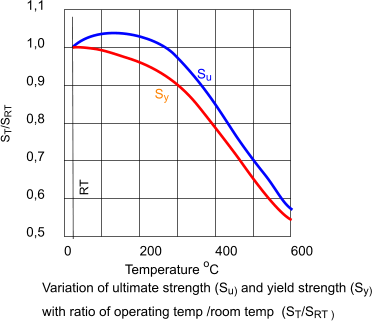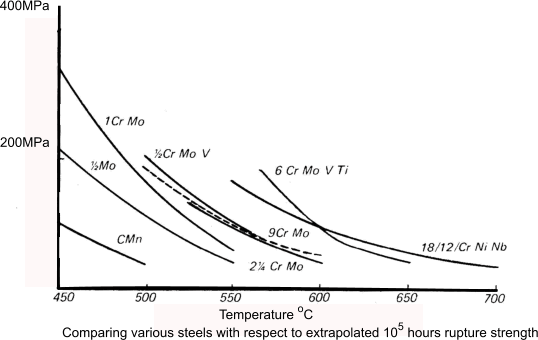Temperature Effects on Metal Strength
The notes below are intended to provide general guidance to the affect of high and low operating temperatures on the strength of metals. They should only be used for initial appraisal of the suitability of metals for operating conditions away from ambient. For detailed assessment the material suppliers must be consulted.
Metals are generally specified for operating at or about the ambient /room temperature (about 20°C). When a metal is used away from this temperature its properties are affected. In general a metal becomes weaker and more ductile at elevated temperatures and becomes brittle at very low temperatures. The metal standard often allow for this by specifying low temperature tests for metals to be used at lower temperatures.
Most ferrous metals have a maximum strength at approximately 200°C. the strength of non-ferrous metals is generally at a maximum at room temperature. The table below shows how the strength of some typical metals vary at elevated temperatures
The modulus of elasticity of metals decreases with increasing temperature above room temperature until it falls of rapidly and is zero at the melting point.
Table showing the strength of certain metals as a % of their strength at 20°C as the operating temperature is increased.
| Material |
Temperature oC |
| 100 |
200 |
300 |
400 |
500 |
| Wrought Iron |
104 |
112 |
116 |
96 |
76 |
| Cast Iron |
- |
100 |
99 |
92 |
76 |
| Steel Castings |
109 |
125 |
121 |
97 |
57 |
| Structural Steel |
103 |
132 |
122 |
86 |
49 |
| Copper |
95 |
83 |
73 |
59 |
42 |
| Bronze |
101 |
94 |
57 |
26 |
18 |
List of Metals used at high temperatures
Tungsten
Tantalum
Molybdenum
Chromium
Vanadium
Titanium
Nimomic alloys
|
Stellite
Hastelloy
Inconel
Stainless Steel
Nichrome
Heat-Resisting alloy Steels
|
Steels-Elevated Temperatures
The graph below shows the relationship between The ultimate and yield strengths of various l grades of carbon and alloy steel with the ratio of operating temperature to room temperature

All metals creep?under stress at high temperature and in their manufactured form, components may deform. In fact for high temperature applications creep is generally the important criteria in the selection of metals
Looking at the graph above the air cooled steel results in the finest grain structure and the best creep strength. The slow cooled steel had about 20% ferrite in the structure. The quenched steels results in course precipitates in the grain structure.
The effect of alloying on the long term creep resistance of steels is shown in the figure below.

Steels-Low Temperatures
At temperatures below -10°C typical steels become more brittle and the toughness is affected. Using selected grades of carbon steel it is possible to operate at temperatures down to -40°C. At these low temperatures it is necessary to conduct specific impact tests at low temperatures on the selected steel to confirm suitability. Austentic stainless steels are generally suitable for applications down to, and below, -40°C
Austenitic Stainless steel is particulary useful in cryogenic applications beacause of its high toughness and strength at very low temperatures 304 (X10CrNi18-8 ) stainless steel can be readily employed to handle liquid helium and liquid hydrogen (-268,9 and -252.7°C respectively). 9% nickel alloy steels retain good notch ductility down to -196°C and have been used for manufacture of vessels holding liquid oxygen and liquid methane(-182,9 and -161,5°C respectively).
Non-ferrous metals - Low Temperatures
Aluminum alloys are used for structural parts for operation at temperatures as low as ( -270°C ). Below zero, most aluminum alloys show little change in properties, the yield and tensile strengths may increase, elongation may decrease slightly and impact strength remains approximately constant. Consequently, aluminum is useful material for many low-temperature applications.
Copper and copper alloys are widely used for refrigeration components operating at temperatures down to -40°C.
Related References:
High Temperature And Corrosion Resistant Alloys
Temperature Effects on Metal Strength
High Temperature Stainless Steel Tubes
High Temperature Stainless Steel Tubes
High Temperature Property Stainless Steel
Heat resistant Stainless Steel Tubes
High Temperature Change Stainless Steel Mechnical Properties
Sparking Risks in Explosive Gas Atmospheres
Maximum Service Temperature in Air for Stainless Steel
| 